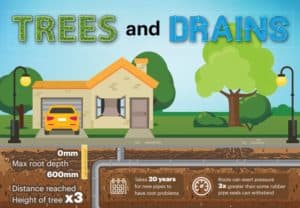Tree roots are often blamed for damaging drains and other underground structures – but what is the truth of the matter? And what should you do to prevent any problems occurring?
Here at UKDN Waterflow (LG) Ltd, our drainage teams certainly often have to remove roots from drains and sewer pipes. It is a common cause of pipe blockages.
Also, many people who have trees in their gardens will be receiving advice about how to manage them to prevent roots spreading and causing problems. Some may be told the trees must be chopped down.
However, the truth of the matter is not completely simple, as our white paper, Trees – Getting To The Root Of The Issue, makes clear.
We have drawn together all the relevant research, expert opinion and best practice, which reveals that some trees may not be the menace some believe them to be.
We have also created an infographic to showcase the most important issues to consider about tree roots and drain or sewer damage.
Key findings in the white paper are:
- Tree roots only risk causing damage to built structures within a two-metre radius of the trunk. Most buildings further away will not be affected.
- Tree roots get into drains because there is a defect in the pipes. There is no evidence that they can create cracks to break into them.
- However, once roots have exploited the defect, which could be a crack or displaced joint caused by pipe subsidence, they can widen them by expanding as they grow.
- Some trees have more active root systems than others so are more likely to exploit defects and get into pipes while seeking water and nutrients.
- If you are concerned about trees infestation of pipes or other utilities, such as cable ducting, there are ways to restrict their activity, for example by planting them in root boxes.
UKDN Waterflow (LG) Ltd Director Richard Leigh, the White Paper’s author, said: “Over the coming months, as people get out into the garden, I have no doubt a lot of trees will be chopped down on the pretext of preventing damage to drains and buildings.
“But our white paper shows, careful thought is needed before action is taken. Roots in drains is likely to be more of an indicator that it is the maintenance of the drain that needs to be looked at first.”
Root infestation can be a significant problem. It can lead to sewage backing up into homes and business premises, causing flooding and unpleasant damage, so risks do need to be taken seriously.
The white paper contains best practice advice on measures that can be taken to reduce associated risks. Recommended actions include:
- Put in place a rigorous planned and preventative drainage maintenance (PPM) programme, including CCTV surveys, to identify pipes most at risk and catch tree root ingress at an early stage.
- Review tree planting plans and avoid species that have particularly vigorous root systems, such as willow, plane, poplar and maple – and among more exotic varieties, rubber, fig and gum trees.
- Keeping pipes clean through water jetting, to prevent a build-up of silt and other nutrients, and water pooling, that can encourage root growth.
- Removing tree roots with the most appropriate, cost-effective no-dig method. This may involve water jetting, electro-mechanical cutting, or robotic cutting.
The UKDN Waterflow (LG) white paper Trees – Getting To The Root Of The Issue can be viewed and downloaded here.

